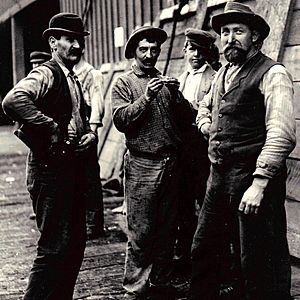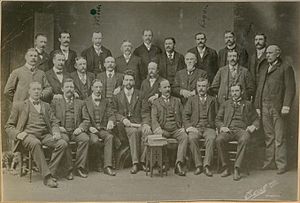Union Labor Party (California) facts for kids
Quick facts for kids
Union Labor Party
|
|
|---|---|
| Leaders | Eugene Schmitz, Charles Boxton, Patrick H. McCarthy |
| Founded | 1901 |
| Dissolved | 1912 |
| Headquarters | San Francisco |
| Ideology | Nativism Labor rights Closed shop politics |
The Union Labor Party was a political group in San Francisco, California. It was active in the early 1900s. This party focused on the rights of working class people. It also supported a belief called nativism, which favored people born in the country. The party became very important in the labor movement and city politics after 1901. It even helped elect its candidate as Mayor of San Francisco in 1909.
Contents
How the Party Started
Why the Party Formed
At the start of the 1900s, many employers in America used court orders to stop worker unions from going on strike. These strikes aimed to get better pay and working conditions. This was part of a movement called the "open shop drive." It made it hard for unions to gain power.
In San Francisco, a city with many unions, things got difficult in 1901. A group of employers, the Draymen's Association, stopped their unionized teamsters from working. This is called a lockout. It happened on July 21. The lockout quickly spread to the entire waterfront. This caused transportation in the city to almost stop.
Employers brought in Strikebreakers, people who would do the work of the striking employees. The union workers tried to stop them, sometimes with force. Employers then asked the police for help. When police arrived, 14 maritime unions joined together. They formed the City Front Federation. They decided to start a large sympathy strike to support the teamsters. They did not want the teamsters' union to be crushed. About 16,000 longshoremen, clerks, and warehouse workers joined the strike on July 30. This made the situation even more tense.
San Francisco's Democratic mayor, James D. Phelan, had been elected with support from unions. But he sided with the employers. He told the police chief to stop the strike. A lot of violence followed. Workers on strike were hit and even shot. Five people died, and 336 assaults were reported. Hundreds more strikers were arrested.
The workers felt that Mayor Phelan had betrayed them. This made San Francisco's unions rethink their plan. Before, they tried to elect friends in the Democratic and Republican parties. Now, they wanted their own political group. They hoped to elect their own people to power. This way, the city's power would not be used against them in future strikes.
The Union Labor Party was created because of this new idea.
The Union Labor Party is Born
On September 5, 1901, about 300 representatives from 68 San Francisco unions met. They formed the Union Labor Party of the City and County of San Francisco. They agreed on a plan of action. This plan included changing the city charter to stop the city from interfering in worker disputes. They also wanted the city to own all public services. They called for more schools and a fair system for promoting teachers. They also wanted to get rid of the poll tax. The plan also asked for limits on Asian immigration. It also wanted separate schools for Asian children.
The new party chose Eugene Schmitz, who was the president of the Musicians' Union, as its candidate for Mayor. A lawyer and political leader named Abe Ruef strongly supported Schmitz. The party also nominated candidates for all other elected positions. Almost every union in San Francisco supported the party. Only the local Building Trades Council did not. Most newspapers were against the party. Only the San Francisco Examiner, owned by William Randolph Hearst, supported it.
The election in November 1901 was a big win for the party. Their mayoral candidate won by more than 20,000 votes. Three of their members were elected to the San Francisco Board of Supervisors. They almost elected three more, missing by only 50 votes.
Right after the election, the teamsters' strike ended. The unions won. Strikebreakers were let go, and the union workers got their jobs back. The Teamsters Union was recognized. They got their union wage, and a 48-hour work week was set. The union did not immediately get a closed shop, where only union members can work. But 1901 was still a major victory for unions in San Francisco and their Union Labor Party.
The Union Labor Party in Power
With the Union Labor Party in charge of City Hall, San Francisco's unions started more successful strikes in 1902. The city's streetcar workers went on strike. They wanted to reverse a pay cut from 1901 and get union recognition. This strike made transportation in San Francisco very difficult. The United Railway Company, which employed the streetcar workers, tried to bring in strikebreakers. But this time, the Union Labor Party Mayor stopped the company from getting police protection. He also ordered that no special permits be given for security guards to carry guns. Eight days later, the company signed a contract with its employees. The union got all its demands.
Even though some national union leaders like Samuel Gompers had doubts, the Union Labor Party kept winning elections. In 1903, Eugene Schmitz was chosen again for Mayor of San Francisco. He won re-election by more than 26,000 votes.
Groups against unions were defeated in the elections. But they did not stop organizing. In 1904, a new group called the Citizen's Alliance came to San Francisco. It was led by Herbert George, a leader of the open shop movement. George had started the Citizens' Alliance in Denver, Colorado, and it was very successful there. By the end of 1904, George's group claimed 16,000 members. These members were employers who promised to bring back "the Americanism of the Open Shop in San Francisco."
In the 1905 election, the Citizens' Alliance tried to divide the unions. They started a fake group called the United Labor League. The Citizens' Alliance hoped the labor movement would split. They thought the conservative Building Trades Council, led by P.H. McCarthy, would go against the Union Labor Party. Then, Republicans and Democrats would join forces under the slogan "Law and Order."
But their plans did not work. McCarthy and the Building Trades Council, who had been against Schmitz before, united behind him and the Union Labor Party in 1905. This helped Schmitz win a third term as mayor.
The Union Labor Party's Decline
The year 1907 was a turning point for the Union Labor Party. That year, problems with money and unfair dealings in the city government came to light. An investigation showed that the Union Labor Party and the Mayor were controlled by political leader Abe Ruef. He received money, disguised as legal fees, from public services and gambling places. Mayor Eugene Schmitz's problems happened during the San Francisco Streetcar Strike of 1907. This hurt the strike effort. The strike failed after months of violence between the Carmen's Union and paid strikebreakers from out of town.
Even though similar problems happened in other big American cities, the San Francisco situation caused a lot of criticism. Local and national newspapers strongly linked unions with dishonesty.
In 1909, the Union Labor Party's plan included public ownership of services, a new city auditorium, and many public works projects. They also wanted a policy to hire only U.S. citizens. The Union Labor Party nominated and elected the conservative P. H. McCarthy of the San Francisco Building Trades Council in the 1909 mayoral election. McCarthy's time as mayor was mostly free of money problems, but he had some political failures.
Business leaders chose James Rolph, Jr., known as "Sunny Jim," to run against McCarthy in 1911. Rolph won that election. After this, the Union Labor Party slowly disappeared.



